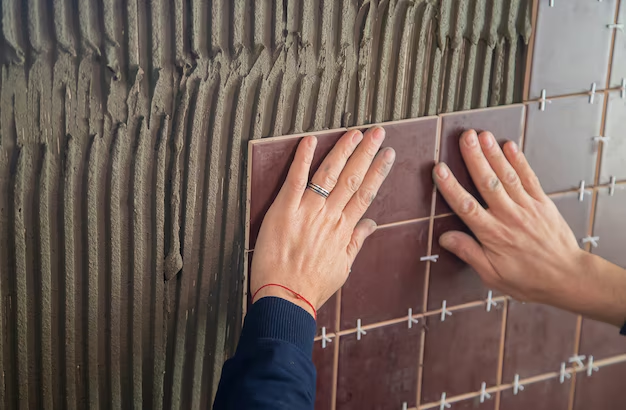For centuries, tiles have been a fundamental element in home design, blending both practicality and visual charm flawlessly. Found adorning kitchen backsplashes, shower walls, and even outdoor patios, tiles present an array of shapes, sizes, and materials, unlocking boundless design avenues. But amidst their allure, one might ponder: how does tile work unfold in practice?
In this complete guide, we dive into the intricacies of tile installation, unveiling a step-by-step journey from groundwork to final flourishes. Explore the artistry and technique behind laying tiles, from precise preparation of surfaces to the precise application of adhesives. Discover the nuances of grouting and sealing, essential for both durability and aesthetics. Whether you’re tackling a DIY project or engaging professional services, understanding the fundamentals of how tile work is executed empowers you to craft spaces that marry functionality with beauty flawlessly. Join us as we manage through the realm of tile installation, unlocking the secrets behind its enduring allure and timeless appeal. Learn how does tile work and master the art of transforming spaces with tiles. Dive into the world of refinishing and remodeling.
The Step-by-Step Look into the Process
1. Planning and Preparation
Before any tile work begins, thorough planning and preparation are essential
Surface Preparation
The surface where the tiles will be installed must be clean, flat, and free of any debris or imperfections. This may involve removing existing flooring or wall coverings and repairing any cracks or uneven areas.
Tile Layout
Determine the layout and pattern of the tiles, taking into account factors such as the size and shape of the tiles, the dimensions of the space, and any architectural features.
Material Selection
Select the type of tiles that align best with your project’s requirements, taking into account factors such as durability, moisture resistance, and aesthetic preferences. Common options, including ceramic, porcelain, glass, and natural stone tiles, offer various qualities crucial in understanding how does tile work.
2. Setting the Tiles
Once the planning and preparation are complete, it’s time to start setting the tiles
Applying Adhesive
Use a suitable adhesive or mortar to adhere the tiles to the surface. The type of adhesive used will depend on factors such as the type of tiles and the substrate material.
Tile Placement
Begin placing the tiles according to the predetermined layout, using tile spacers to ensure even spacing between tiles. Use a level to ensure that the tiles are aligned correctly and maintain uniformity throughout the installation.
Cutting Tiles
Inevitably, some tiles will need to be cut to fit around obstacles such as pipes, corners, or irregularly shaped spaces. Use a tile cutter or wet saw to make precise cuts, taking care to measure accurately before cutting.
3. Grouting
Once all the tiles are in place, the next step is to grout the joints between them
Mixing Grout
Mix the grout according to the manufacturer’s instructions, ensuring that it reaches the desired consistency.
Applying Grout
Use a grout float to apply the grout to the tile joints, pressing it firmly into the gaps. Work in small sections at a time, and be sure to remove any excess grout from the tile surfaces before it dries.
Cleaning
After the grout has dried slightly, use a damp sponge to wipe away any remaining grout residue from the tile surfaces. Allow the grout to cure fully before proceeding to the next step.
4. Finishing Touches
With the tiles set and grouted, the final step is to add finishing touches:
Sealing (if necessary
Depending on the type of tiles used, sealing may be necessary to protect them from moisture, stains, and other damage. Applying a suitable sealant according to the manufacturer’s instructions is crucial in understanding how does tile work, ensuring proper coverage across the entire surface to maintain durability and aesthetics.
Installing Trim and Edging
Install trim pieces or edging tiles along the edges of the tiled area to create a clean and finished look. This may involve using bullnose tiles, metal edging, or other decorative elements.
Cleaning and Maintenance
Once the installation is complete, clean the tiled surface thoroughly to remove any remaining grout residue or debris. Follow proper maintenance procedures to keep the tiles looking their best for years to come.
In conclusion, tile work is a process demanding precision and attention to detail, from inception to completion. Each phase, thoughtfully planned and executed, contributes to the overall quality of the installation. By following this systematic guide and leveraging the expertise of professionals such as Hollywood Refinishing, you can ensure the creation of striking tile arrangements that not only enhance the visual appeal but also optimize functionality within any space. Whether renovating a kitchen, bathroom, or any other area of your home, comprehending how tile work unfolds is fundamental to achieving desired outcomes. Embrace the journey of tile installation, where careful planning and skilled execution converge to transform spaces into exquisite reflections of your vision and style, ultimately answering the question: how does tile work? Inspired? Contact us now to learn more about tile installation and remodeling.
Frequently Asked Questions
1. What materials are commonly used for tile installation?
Common options include ceramic, porcelain, glass, and natural stone tiles, each offering unique properties suitable for various projects. Understanding the characteristics of each material is crucial for achieving desired outcomes in how does tile work.
2. Do I need to remove existing flooring before installing tiles?
Yes, thorough surface preparation is essential. This involves removing existing flooring or wall coverings to ensure a clean, flat surface for tile installation.
3. How do I ensure the tiles are aligned correctly during installation?
Using tile spacers helps maintain even spacing between tiles, while a level ensures they are aligned correctly. These tools are vital for achieving uniformity in how does tile work.
4. What is the purpose of grouting, and how is it done?
Grouting fills the joints between tiles, providing stability and preventing moisture penetration. After setting the tiles, mix the grout to the desired consistency, apply it with a grout float, and clean off excess before it dries.
5. Do all types of tiles require sealing?
It depends on the tile material. Porous materials like natural stone typically require sealing to protect them from moisture and stains. Follow manufacturer instructions to determine if sealing is necessary in how does tile work.
6. Can I install tiles myself, or should I hire a professional?
While DIY tile installation is possible, it requires careful planning and execution. Hiring a professional ensures expertise in how does tile work, particularly for complex projects or when dealing with specialty materials.
7. How do I maintain tiled surfaces for longevity?
Regular cleaning is essential to remove dirt and grime. Follow proper maintenance procedures and use suitable cleaning products to preserve the tiles’ appearance and functionality in how does tile work.





